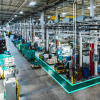
Heading
Smart Manufacturing Blog
Description
Welcome to your source for all things smart manufacturing. Whether you’re looking for expert insights, hard data, or actionable tips for your plant floor, we’ve got you covered every week of the year.

Now Available!
Get your copy of the 7th Annual State of Smart Manufacturing and hear from 300+ manufacturers in this new survey report!
Production Management
Plex Manufacturing Blog
How an Advanced ERP Improves Standard Production Costing and Profitability
With turbulent supply chains and an ever-shifting industry landscape, there’s no way to know your precise manufacturing costs in advance. However, you can rely on standard costing to provide reasonable estimates – if you have the right tools to tackle the task. Advanced enterprise resource planning (ERP) systems can provide cost visibility, resource planning, and real-time analytics to make…
Read MoreOvercoming Challenges to Becoming an Operations Leader
Leadership within a complex operational structure has never been easy. Now, new pressures are making this level of responsibility even more challenging....
Read MoreAutomotive Manufacturing Trends for the Balance of the Decade
Each year brings new predictions of the future. These predictions include what to expect, what will happen, and which technologies will power the expectations.While these predictions are always interesting to consider, they should be kept in the context of reality to have value for automotive manufacturers. With a rapidly evolving landscape, this industry is producers are under intense pressure…
Read MoreWhen Customers Come Knocking: The Link Between Demand and Execution
There's an old business phrase that says that the customer is always right. While many companies have tied themselves into knots trying to service ever-changing consumer tastes, there is one area they often neglect to address in their efforts.What if the message customers send points to your system more than your product? And what if the things they ask for require you to abandon a manual system…
Read MoreDigital Building Blocks for Operational Efficiency
As Industry 4.0 continues to shape industries across the globe, one of the most significant beneficiaries of the power of these technologies is operational efficiency within manufacturing.This is particularly true with the rise of the role of robots in manufacturing industries and the supply chain....
Read MoreDigital Building Blocks for Sustainability: Part 2
There is increasing interest in reducing carbon emissions as part of overall sustainability. This particularly applies to manufacturing where both awareness and regulations are encouraging producers to explore ways to mitigate or eliminate their emissions.Continuing our discussion of sustainability as a digital building block in manufacturing, let's look at how software can help monitor, track,…
Read MoreWhy Manufacturers Must Embrace Data-Driven Operations
There was a time in manufacturing before personal computers (PCs). Data was manually tracked, and decisions were made based on experience, gut feelings, and guesswork. But the lowly PC changed all that. Suddenly, companies could store more data and utilize spreadsheets to analyze operational aspects.As much as that was a big leap in operational improvement, it still relied on an overabundance of…
Read MoreIs Your Manufacturing Operation a Haunted House?
A door opens with a creaking sound. Faint groans are heard just around the corner. And the distinct sight of a completely bandaged entity is seen shuffling down a corridor. Is it a haunted house? A scary abandoned building? Or is it your manufacturing process?While haunted houses can be a fun way to celebrate Halloween, they’re not so fun when they reflect a harsh reality within your plant. That…
Read MoreWhere Did My Plant Performance Go?
An ERP system must be fed with insights from several data sources or software systems, and that data must be accurate. Plant performance suffers if the data tracking and analysis are manual or the software is inaccurate. Even if companies use software, it’s critical to use the right combination of software to improve performance....
Read MoreThink Strategically to Act Tactically
Having a sound strategy can make all the difference in war, life, and business. With it, there are clear goals and directions on where you are going and how you will get there. Without it, you risk wandering, moving from band-aid to band-aid to fix problems....
Read MorePagination










